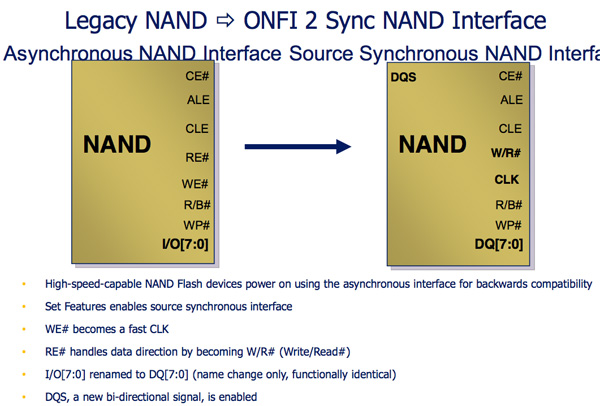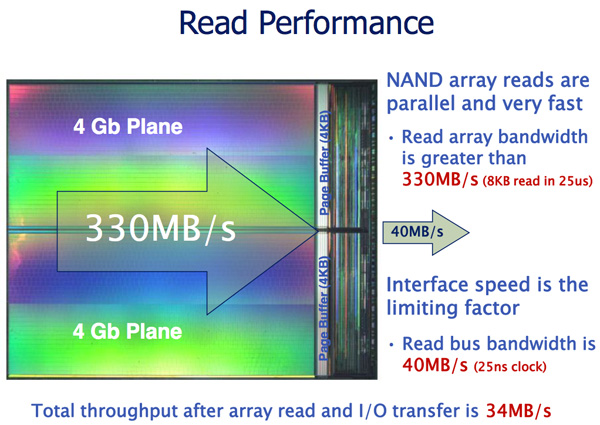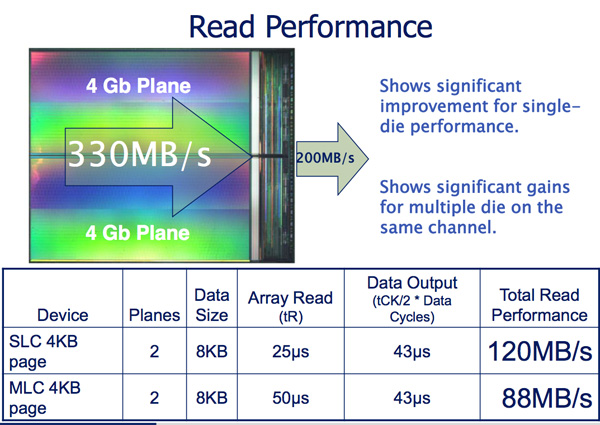SandForce Announces Next-Gen SSDs, SF-2000 Capable of 500MB/s and 60K IOPS
by Anand Lal Shimpi on October 7, 2010 9:30 AM ESTNAND Support: Everything
The SF-2000 controllers are NAND manufacturer agnostic. Both ONFI 2 and toggle interfaces are supported. Let’s talk about what this means.
Legacy NAND is written in a very straight forward manner. A write enable signal is sent to the NAND, once the WE signal is high data can latch to the NAND.
Both ONFI 2 and Toggle NAND add another bit to the NAND interface: the DQS signal. The Write Enable signal is still present but it’s now only used for latching commands and addresses, DQS is used for data transfers. Instead of only transferring data when the DQS signal is high, ONFI2 and Toggle NAND support transferring data on both the rising and falling edges of the DQS signal. This should sound a lot like DDR to you, because it is.

The benefit is tremendous. Whereas the current interface to NAND is limited to 40MB/s per device, ONFI 2 and Toggle increase that to 166MB/s per device.

Micron indicates that a dual plane NAND array can be read from at up to 330MB/s and written to at 33MB/s. By implementing an ONFI 2 and Toggle compliant interface, SandForce immediately gets a huge boost in potential performance. Now it’s just a matter of managing it all.
The controller accommodates the faster NAND interface by supporting more active NAND die concurrently. The SF-2000 controllers can activate twice as many die in parallel compared to the SF-1200/1500. This should result in some pretty hefty performance gains as you’ll soon see. The controller is physically faster and has more internal memory/larger buffers in order to enable the higher expected bandwidths.

Initial designs will be based on 34nm eMLC from Micron and 32nm eMLC from Toshiba. The controller does support 25nm NAND as well, so we’ll see a transition there when the yields are high enough. Note that SandForce, like Intel, will be using enterprise grade MLC instead of SLC for the server market. The demand pretty much requires it and luckily, with a good enough controller and NAND, eMLC looks like it may be able to handle a server workload.










84 Comments
View All Comments
Zan Lynx - Friday, October 8, 2010 - link
People will be able to get what they want and/or need based on what they can afford.The guys who pay for custom painted cases with three GPUs and water cooling will probably want to throw in a 4GB/s storage "drive".
The ordinary people will be happy enough if their games and word processor open in less than 10 seconds so they will be paying for the cheap drives.
The enterprise folks will throw a half-million dollars at a SAN vendor and say "Make it work really really fast." Heh.
iwodo - Sunday, October 10, 2010 - link
1. reads 330MB/s and writes 33MB/s ?? I think you need reference to backup your "facts" DDR /Toggle Mode NAND only reads @ 166Mbps ( Mega Bits, Not Bytes as you reference )But yes, NAND SSD speed is easily scalable. ( As i mentioned in previous comment which i asked the same question )
We will be limited by controller, someday due to all the error correction, overhead etc. But that is still very far off.
In the thread i posted in forum about Diminishing returns of SSD Speed. Basically concludes we have already / near reach that tipping point. Because under very limited situation you will ever need 4GB/s Read write speed. It is the Random Read Write that will count.
However software still assume we are on HDD, therefore we will be limited to OS, drivers and other side of software to see any other performance difference.
Keatah - Friday, October 15, 2010 - link
Uhm yeh, that's what they said about 640k! Nobody is gonna need more than 640k!I would stick to mechanical drives to meet those requirements. SSD's are anything but bug-free and stable and cheap. Not yet.
JonnyDough - Friday, October 8, 2010 - link
"Performance: Welcome to the 500 Club"As long as its nothing like The 700 Club. Those crackers are so off base its scary. :P
Arbie - Friday, October 8, 2010 - link
This reminds me very much of the Hewlett-Packard cartridge tape drives of the mid-nineties. They were sold as "250MB" although they really only held 125MB. The fake rating was created by assuming all your data could be compressed by 50% !! Impressive work by HP - advancing the standard of US technical innovation.
Anyway, I really hope Anandtech will test these SSDs with compressed files as well.
PeanutGallery - Friday, October 8, 2010 - link
Will I be able to use the encryption if it's installed in a MacBook Pro? (latest 13 inch)If so, how?
Havor - Friday, October 8, 2010 - link
Even do if these drives come out and will be near enough to the price of a Vertex 2 i will certainly get one, but what i am waiting for even more is a controller whit native PCIe 4x ore 8x support.PCIe 2.x got a bi-directional throughput off 500MB/s per lane, that hold in that PCIe 2.x throughput of 250MB data in and/ore 250MB data out, minus +/- 20% overhead.
PCIe 4x ((4 x 250MB = 1GB) - 20% = 800MB/s) ore PCIe 8x ((8 x 250MB = 2GB) - 20% = 1.6GB/s)
Also saves a lot of steps of the ones currently in use (RevoDrive: SATA > raid controller > PCI-X > PCIe) ore the more expensive ones (other one's: SATA > raid controller > PCIe)
Think they will come it just will take time.
aviv - Saturday, October 9, 2010 - link
hey anand all winsxs dir in vista or windows 7 are dupes files that make the test not rightsoonlar - Monday, October 11, 2010 - link
"At full speed you could copy 1GB of data from a SF-2000 drive to another SF-2000 drive in 2 seconds. If SandForce can actually deliver this sort of performance I will be blown away."1GB?
Keatah - Friday, October 15, 2010 - link
Anyone that buys an SSD today is an early adopter. These drives are not consumer grade and definitely not prime-time ready.Another 2 years. Then we're good to go. Simple as that!